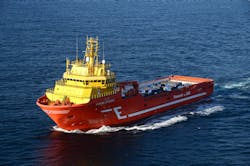Research project to test zero emission technology on Viking Energy
Offshore staff
STAVANGER, Norway – Equinor and Eidesvik Offshore have agreed to modify the supply vessel Viking Energy to make it capable of covering long distances fueled by ammonia.
Earlier this week Equinor awarded Eidesvik a five-year contract with effect from April 2020, when the current contract expires. In the contract period, the Viking Energy will be part of a research project developing, installing, and testing long-distance sailing fueled by ammonia fuel cells. The technology will be tested on the vessel in 2024.
Cecilie Rønning, senior vice president for Equinor’s joint operations support, said: “Equinor aims to reduce the emissions in our supply chain, and regards the use of ammonia as a promising solution. Viking Energy may become the first supply vessel in the world covering long distances fueled by pure carbon-free ammonia.”
Equinor is part of the ShipFC project, a consortium of 14 European companies and institutions coordinated by NCE Maritime Cleantech. The main partners of the five-year research project are NCE Maritime Cleantech, Eidesvik, Wärtsilä, Prototech, and Equinor. Wärtsilä will deliver the power technology and ammonia storage and distribution systems. Prototech will deliver the fuel cell system.
The project will test whether the technology can deliver 100% carbon-free power over long distances.
Vermund Hjelland, vice president of technology and development at Eidesvik Offshore, said: “As part of the testing, the vessel will use ammonia in transit between harbor and offshore installations for one year. In addition, we envisage that ammonia will be used to power the vessel when alongside quay.
“Our ambition is that 60 to 70% of the energy consumption will come from ammonia during the test period. In addition, we want to demonstrate that the technology can supply up to 90% of the total power demand.”
The Viking Energy will still be able to use LNG as fuel, and the remaining power requirement will be met by battery.
Ammonia research on the Viking Energy has a total budget of NOK 230 million ($26 million), a substantial part of which is EU funded. According to Equinor, the partners also have a good dialogue with Innovasjon Norge and Enova about potential additional funding of the project.
Since the early 2000s, the company said it has proactively addressed ways of cutting emissions from supply vessels on the Norwegian continental shelf. The Viking Energy was the first LNG-fueled vessel in Equinor’s fleet in 2003, and the first vessel with hybrid battery power in 2016.
During 2020 all the 19 supply vessels on long-term contracts with Equinor will feature battery power and power from shore.
Earlier this year, Equinor and the Konkraft partners launched a joint ambition to reduce the greenhouse gas emissions from oil and gas operations in Norway by 40% by 2030, and to near zero by 2050.
01/23/2020
